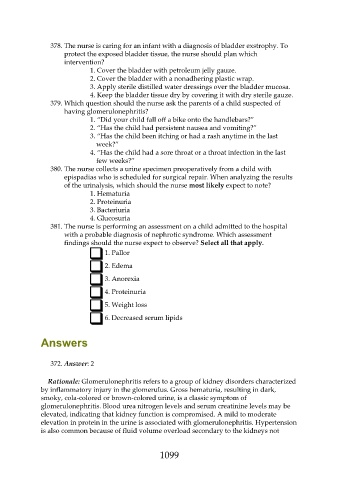Page 1099 - Saunders Comprehensive Review For NCLEX-RN
P. 1099
378. The nurse is caring for an infant with a diagnosis of bladder exstrophy. To
protect the exposed bladder tissue, the nurse should plan which
intervention?
1. Cover the bladder with petroleum jelly gauze.
2. Cover the bladder with a nonadhering plastic wrap.
3. Apply sterile distilled water dressings over the bladder mucosa.
4. Keep the bladder tissue dry by covering it with dry sterile gauze.
379. Which question should the nurse ask the parents of a child suspected of
having glomerulonephritis?
1. “Did your child fall off a bike onto the handlebars?”
2. “Has the child had persistent nausea and vomiting?”
3. “Has the child been itching or had a rash anytime in the last
week?”
4. “Has the child had a sore throat or a throat infection in the last
few weeks?”
380. The nurse collects a urine specimen preoperatively from a child with
epispadias who is scheduled for surgical repair. When analyzing the results
of the urinalysis, which should the nurse most likely expect to note?
1. Hematuria
2. Proteinuria
3. Bacteriuria
4. Glucosuria
381. The nurse is performing an assessment on a child admitted to the hospital
with a probable diagnosis of nephrotic syndrome. Which assessment
findings should the nurse expect to observe? Select all that apply.
1. Pallor
2. Edema
3. Anorexia
4. Proteinuria
5. Weight loss
6. Decreased serum lipids
Answers
372. Answer: 2
Rationale: Glomerulonephritis refers to a group of kidney disorders characterized
by inflammatory injury in the glomerulus. Gross hematuria, resulting in dark,
smoky, cola-colored or brown-colored urine, is a classic symptom of
glomerulonephritis. Blood urea nitrogen levels and serum creatinine levels may be
elevated, indicating that kidney function is compromised. A mild to moderate
elevation in protein in the urine is associated with glomerulonephritis. Hypertension
is also common because of fluid volume overload secondary to the kidneys not
1099

